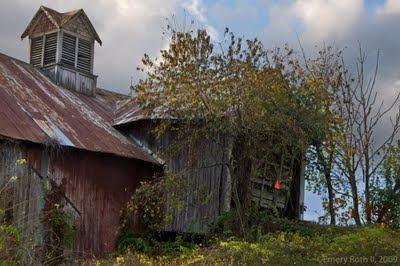
PHOTOGRAPHER'S JOURNAL: Everything beyond the dairy yards is running wild. He's not a bull, but there's probably no convincing him of that, nor do the other steers or the heifers seem to realize he's really just an ex-bull. There are several of these ex-bulls in the herd. I'm sure they each have a social rank, but I can only guess which one is chief ex-bull. They watch me more closely than do any of the other cattle, and I watch them back with equal attention. Beef cattle require little handling, and at Twin Elm they're left pretty much to themselves as they wander the extensive fields. As a result, they're on their guard when the strange guy with the tripod comes through.
Everything beyond the dairy yards is running wild. The fields are shrinking, being reclaimed by wild bittersweet and thistle, and other things with thorns, barbs, spikes, or spines that cows won't eat and people can't traverse. In some places fields have been abandoned entirely, though here and there they are penetrated by narrow channels through the brush, passageways kept clear by the cows and often only passable by cows. And the water that flows down the mountainside, long ago washed out much of the farm drainage system. Muddy areas trampled by the herd are often nearly impassable by human feet. I may meet parts of the beef herd almost anywhere up the mountainside. Beyond the dairy yards everything is running wild.
The ex-bulls take seriously their duty to guard the herd, and I respect that, but they are not brave, and so we do this little dance as I make my pictures. Cattle raised without regular human contact maintain a safe zone. Their eyes are on the sides of their heads giving them wide-angle vision. With their heads pointing forward they can see everything from shoulder blade to shoulder blade. Of course they turn their heads to extend this vision, but there's a blind spot at the back and a point of balance. If I enter the blind spot they will turn. If I encroach on their safe zone from behind the shoulder blades, they will move forward and away from me. In this way I can kind of herd them into positions where the light is right or the background interesting for my photographs.
Sometimes the ex-bulls will try to herd me, but I've learned not to retreat from my own safe zone. They do this slowly. They're probably not trying to herd me so much as approach on their own terms to satisfy their curiosity. However, I preserve my safe zone. When the ex-bull gets too close for comfort I never retreat. I move toward it, and it retreats.
I've read that bulls that grow up with other cattle know they are bulls. Individually raised bulls may think they are people and challenge approaching people for dominance. I have no idea how each of the animals in the Twin Elms herd was raised, and I try to watch signals closely. At the end of a shoot, as I leave the pasture, I always keep one eye behind me.
There have been times when several ex-bulls converged around me. Being surrounded by so many tons of beef surmounted by sharp horns is not comfortable. Then I'll plot my advance toward one of the converging ex-bulls. Sometimes when I look back the remaining ex-bulls are gently butting heads. Everything beyond the dairy yards is running wild.
*******
The concept of "ex-bull" was adopted from writings of Helga Tacreiter. I found her observations on cow behavior interesting, and suggest these web sites:
http://www.psyeta.org/hia/vol8/tacreiter.htmlhttp://www.cowch.com/index.html
 PHOTOGRAPHER'S JOURNAL: For whatever it's worth, and I assure any enthusiast that it isn't much, the following was based on my observation that cows always show immense curiosity in my tripod. As soon as I take camera in hand and park tripod near by, it becomes a new field of exploration for cow brains to digest. Cows who previously had no thought to move, spot it standing there from across the yard. Many times while distracted photographing one cow, I've turned in time to glimpse another shy from the tripods falling heft, and in time to snatch it up before she moves in to sniff at her fallen prey.
PHOTOGRAPHER'S JOURNAL: For whatever it's worth, and I assure any enthusiast that it isn't much, the following was based on my observation that cows always show immense curiosity in my tripod. As soon as I take camera in hand and park tripod near by, it becomes a new field of exploration for cow brains to digest. Cows who previously had no thought to move, spot it standing there from across the yard. Many times while distracted photographing one cow, I've turned in time to glimpse another shy from the tripods falling heft, and in time to snatch it up before she moves in to sniff at her fallen prey.




















